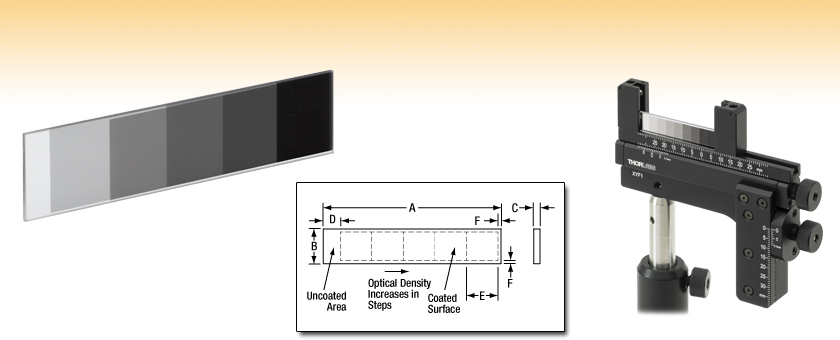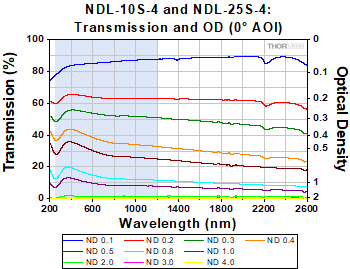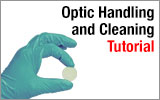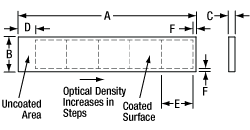Rectangular Step Variable Metallic Neutral Density Filters

- Ideal for Use in Building a Variable Attenuator
- Optical Densities: 0.3 - 2.0 and 0.1 - 4.0
- Two Sizes Available
NDL-25S-2
25 mm x 100 mm
ND Filter
OD: 0.3 to 2.0
Application Idea
NDL-10S-4 Step Variable ND Filter
Held in an XYF1 Translating Filter Mount
(XYF1 Maximum Filter Width: 76.2 mm)

Please Wait
| Variable ND Selection Guide | ||||||
|---|---|---|---|---|---|---|
| Image |  |
 |
 |
 |
 |
 |
| ND Filter Type |
Round Step | Round Continuous |
Cage Compatible |
Rectangular Step |
Rectangular Continuous |
Variable Absorptive ND Filter |
Features
- Provides Discretely Variable Attenuation
- Spectral Range: 240 - 1200 nm
- OD Ranges from 0.1 - 4.0 or 0.3 - 2.0
- Two Size Options
- Commonly Used as Variable Attenuators
Thorlabs' Rectangular Step Variable Metallic (i.e., reflective) Neutral Density Filters provide a discrete range of optical densities (OD) in a single optic. Our rectangular filters are offered in 10 mm x 50 mm and 25 mm x 100 mm sizes (H x W). Both sizes are available with OD ranges of either 0.3 - 2.0 or 0.1 - 4.0. In the versions that span OD 0.3 - 2.0, there are five discrete optical density steps, and in the versions that span OD 0.1 - 4.0, there are ten discrete optical density steps. Please refer to the Specs tab to determine the effective area provided for each step.
Our Rectangular Step Variable Metallic Neutral Density Filters are composed of a UV fused silica glass substrate and a metallic Inconel coating. The UV fused silica substrate used in these filters exhibits high transmission and virtually no laser-induced fluorescence (as measured at 193 nm), making it an ideal choice for applications from the UV to the near IR. While the spectral range's lower limit of 240 nm is limited by the absorption of the light by the substrate, UV fused silica provides good transmission up to 2.1 µm, and thus the upper limit of 1200 nm is dependent on the increased opacity of the Inconel coating. The optical density (OD) for each filter is specified at the design wavelength of 633 nm; some variation in the OD will occur over the usable range.
Optical density (OD) indicates the attenuation factor provided by an optical filter, i.e. how much it reduces the optical power of an incident beam. OD is related to the transmission, T, by the equation

where T is a value between 0 and 1. Choosing an ND filter with a higher optical density will translate to lower transmission and greater reflection of the incident light. For higher transmission and less reflection, a lower optical density would be appropriate. As an example, if a filter with an OD of 2 results in a transmission value of 0.01, this means the filter attenuates the beam to 1% of the incident power.
Inconel is a metallic alloy that ensures flat spectral response from the UV to the near IR. Unprotected metal coatings like this should only be cleaned by blown air, never touched, as contact may cause scratching to the unprotected surface. Although these are reflective ND filters, the Inconel coating does absorb some of the incident light, which limits the use of these filters to low-power applications. Inconel is resistant to aging under normal conditions; however, it will oxidize at elevated temperatures. To prevent oxidation, Thorlabs recommends using these ND filters at temperatures below 100°C. To achieve the best performance light should be incident on the side with the Inconel coating.
For mounting options, the NDL-10S-2 and NDL-10S-4 can be mounted using the XYF1(/M) XY translation filter mount. Please note that a portion of the filter's edges will be covered when held between the two mounting arms.
These filters are not intended to serve as laser safety equipment. For lab safety, Thorlabs offers an extensive line of safety and blackout products that significantly reduces exposure to stray or reflected light.
| Common Specifications | |
|---|---|
| Substrate Material | UV Fused Silicaa |
| Length Tolerance (A & B) | +0.00/-0.25 mm |
| Coating Tolerance (C & D) | ±0.25 mm |
| Coating | Front: Inconel (NiCrFe) Back: Uncoated |
| Spectral Rangeb | 240 - 1200 nm |
| Surface Flatness (@ 633 nm) | 1λ per 25 mm |
| Surface Quality | 60-40 Scratch-Dig |
| Wedge | <3 arcmin |
| Optical Density Tolerance | ±5% (At Each Step) |

Click to Enlarge
Click for Raw Data
Figure 2.2 Transmission and Optical Density of Reflective UVFS ND Filters NDL-10S-4 and NDL-25S-4

Click to Enlarge
Click for Raw Data
Figure 2.1 Transmission and Optical Density of Reflective UVFS ND Filters NDL-10S-2 and NDL-25S-2
Item Specifications
| Item # | Optical Density Stepsa | A | B | C | D | E | F |
|---|---|---|---|---|---|---|---|
| NDL-10S-2 | 0.3, 0.6, 0.8, 1.0, 2.0 | 50 mm | 10 mm | 2 mm | 5 mm | 9 mm | 1 mm |
| NDL-10S-4 | 0.1, 0.2, 0.3, 0.4, 0.5, 0.8, 1.0, 2.0, 3.0, 4.0 | 50 mm | 10 mm | 2 mm | 5 mm | 4.5 mm | 1 mm |
| NDL-25S-2 | 0.3, 0.6, 0.8, 1.0, 2.0 | 100 mm | 25 mm | 2 mm | 10 mm | 18 mm | 2 mm |
| NDL-25S-4 | 0.1, 0.2, 0.3, 0.4, 0.5, 0.8, 1.0, 2.0, 3.0, 4.0 | 100 mm | 25 mm | 2 mm | 10 mm | 9 mm | 2 mm |
| Posted Comments: | |
Pierre-Yves BONY
(posted 2022-07-01 09:36:42.727) Hi,
Is it possible de develop a step ND filters starting from OD 0.01 ?
Thank you.
BR
Pierre-Yves BONY cdolbashian
(posted 2022-07-19 11:45:49.0) Thank you for reaching out to us Pierre-Yves. This is potentially feasible. I have contacted you directly to discuss the specifics of this request. For future custom inquiries, please feel free to contact our Solutions Team at Techsales@thorlabs.com. user
(posted 2021-12-02 08:31:45.787) We have purchased the given "NDL-10S-4 - Step Variable ND Filter". We are using the product for our personal investigation for an under development calibration technique that we work on. We need a rough estimate of the coating thicknesses applied. Please make note that this is not a "sensitive design parameter or content may be subject to copyright" but it is our right as a customer to know a rough estimate of the film thicknesses supplied by the company.
Could you please direct us? YLohia
(posted 2021-12-07 01:32:55.0) Hello, thank you for contacting Thorlabs. Since this is a variable density filter, the coating thickness varies across the surface of the part. A thicker coating produces lower transmission. So we have a coating with a thickness gradient, that varies linearly from 0 (at the high transmission, light colored portion of the filter), to maximum thickness at the high OD, dark portion of the filter. The exact coating thicknesses are proprietary (as mentioned in a previous feedback response below), but the highest OD portion (and thus the thickest part of the coating) is on the order of <250nm. Marianna Testa
(posted 2021-10-27 04:41:44.633) I've purchased a NDL-25S-4.
I need to get the OD/transmittance at variout wevelength betwn 300 and 600 nm.
Is it possible to have the number of the curve in
https://www.thorlabs.com/images/TabImages/UVFS_RegularStep_ND_Filters_Transmission_G2-780.gif ? YLohia
(posted 2022-01-24 03:03:45.0) Hello, thank you for your feedback. This data is now available on this webpage to download. Zahra Mazaheri
(posted 2021-09-10 10:25:49.883) Dear administrator,
could you please provide me with the thickness of the coating?
Regards
Zahra YLohia
(posted 2021-09-10 11:28:32.0) Hello Zahra, thank you for contacting Thorlabs. Unfortunately, we cannot spec the thickness of the coating since that information is proprietary. Nirav Annavarapu
(posted 2020-12-01 05:41:47.02) Hello,
Is it possible for you to provide transmission spectra of the NDL-25S-2 filter (especially the OD2 zone) please?
I measured the attenuation with an LED at 910nm and the transmission appears to be 1.96% instead of 1%.
Thank you YLohia
(posted 2020-12-09 11:16:33.0) Hello, thank you for contacting Thorlabs. The transmission data for these filters would be quite similar to the data we have for our standard fixed OD reflective filters (for example the NDUV520B for OD 2: https://www.thorlabs.com/images/popupimages/NDUV_OD2.gif). The spec for NDL-25S-2 was measured at 633 nm, so ~1.96% would be expected at 910 nm. mspurr
(posted 2018-07-04 14:35:15.15) Can you provide any information on the typical lot-to-lot variation for filter transmission? If I bought several of the Step Variable ND filters, what difference in near-IR transmission could I expect between parts?
Thanks,
Michael YLohia
(posted 2018-07-09 09:09:54.0) Hello, unfortunately, this is not something we test or have a tolerance on since all ND filters are evaluated at 633nm only. That being said, we do not expect significant variation between lots. sven.stephan
(posted 2018-06-23 11:46:50.81) Could you please post the transmission spectrum of the filters in the 'Specs'-tab? I think this would be very useful to all users! YLohia
(posted 2018-06-26 08:46:43.0) Hello, thank you for your feedback. Since we want to provide the best data and due to alignment and mounting issues while taking the measurement with this form of ND filters, we actually refer to the plots from the standard/fixed ND filters here: https://www.thorlabs.com/newgrouppage9.cfm?objectgroup_id=6106. jojovalley
(posted 2017-06-13 12:44:09.037) With regard to variable reflective ND filters, it would be nice to see a reference transmittance spectrum.
https://www.thorlabs.com/newgrouppage9.cfm?objectgroup_id=1624 nbayconich
(posted 2017-06-14 02:10:59.0) Thank you for contacting Thorlabs. We can provide the transmission spectrum of these filters. I will contact you directly with more information. Adam
(posted 2010-04-30 03:13:31.0) A response from Adam at Thorlabs: One good method for mounting these filters would be the following:
1. Mount the filter in a CH1A
2. Mount it on a rail carrier like RC1, via a TR3 post and a PH3-ST post holder
3. Mount the rail carrier to a rail like the RLA0600.
This setup should provide you with the translation necessary to use the product as a variable attenuator. |
 Products Home
Products Home









 Variable ND FiltersStep ND, Reflective
Variable ND FiltersStep ND, Reflective